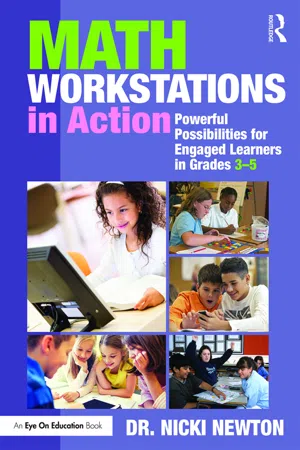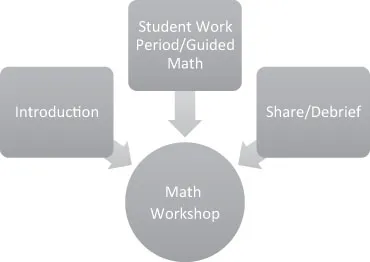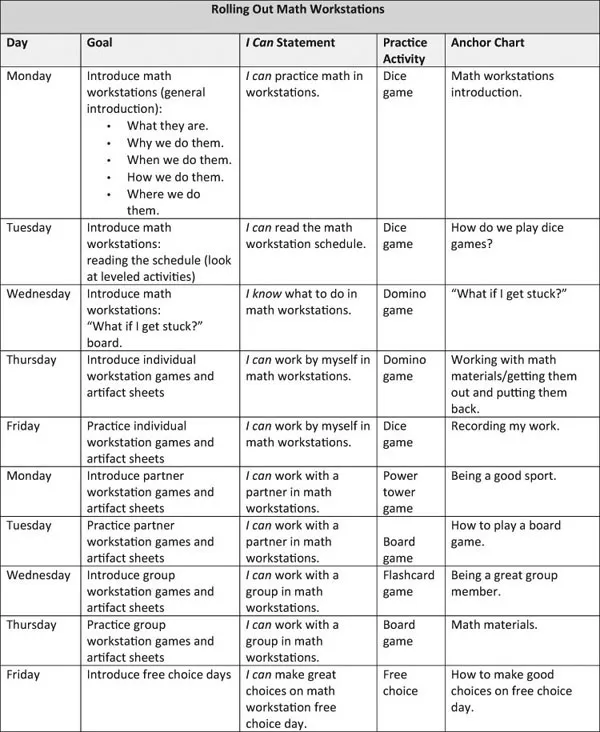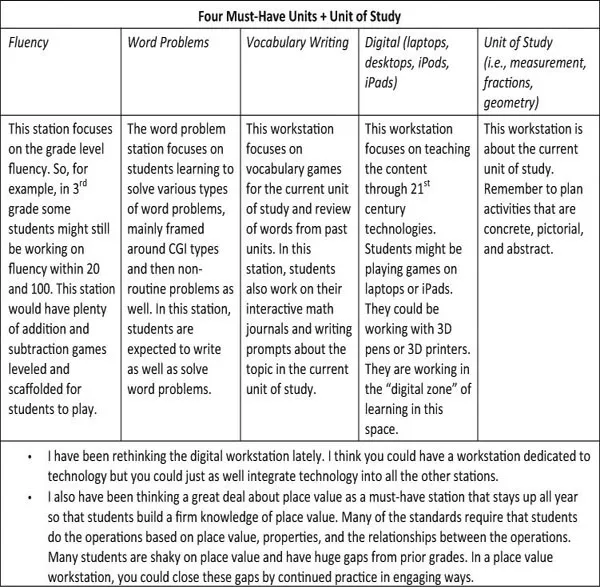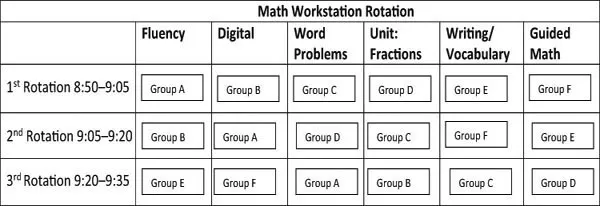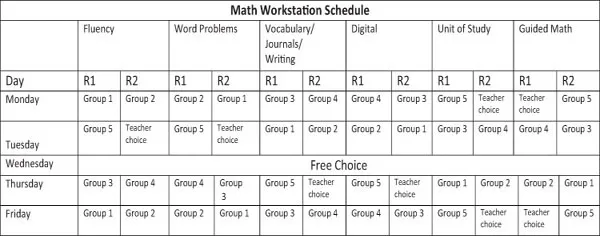![]()
Part I
Overview of Math Workstations
![]()
1
Getting Started
Math Workstations Are a Place for Purposeful Practice!
Math Workstations: Meaningful Practice
Math workstations are spaces and places for students to practice, to get better at math, to go from good to great in what they are doing. They can be done independently, with partners, or in a group. Math workstations are part of a balanced math program. They are meant for purposeful practice. Math workstations can be done in whatever manner best fits your program. Some teachers do them every day in a math workshop daily model. Other teachers do them two or three times a week and do a traditional classroom model on the other days. Some people do whole class explorations, investigations, and lessons on two days and then workstations and guided math groups on the other three days or vice versa.
The most important thing is to start slow. The first thing that people wonder about is where to start. Start small. State standards should frame workstations. Every state has a fluency standard for each grade and word problems. I always encourage teachers to start with these stations. Then, as the year progresses add other stations.
Getting Started
It is important to plan for at least a 20-day rollout. This is the most important part of ensuring that math workstations actually work out. Students need time to learn the set-up of the math block, how to get along with each other, how to talk with each other, and how to work together. It is important to spend time to teach students how to do each of these things. Then, after time has been spent on community building, there must be time spent on the actual workstations.
Math Workstations: One Essential Element of Math Workshop
Math workstations are an instructional strategy that can be used in different math classroom models. Here I want to discuss how math workstations can be one essential element of a math workshop model (see Figure 1.1). In a math workshop model there are three specific elements of the math block. The first part is the introduction. During this part, there is an opening with fluency energizers and routines. After this, there is a mini-lesson about the big ideas in the current unit of study. The second part is the student activity period. It consists of math workstations and guided math groups. Sometimes during this period the teacher does conferences and interviews while students are doing free choice workstations. Guided math groups are done at the same time that the students are in workstations. One of the groups is with the teacher. The third part is the debrief/share. During this part the teacher and students summarize the learning for the day and oftentimes discuss what is happening in the overall unit.
Introducing the Workstations
Remember that the number one rule of workstations is to always teach the workstation to the students before they go there. The teacher should introduce the workstation to the whole class or a small group, depending on the station. If it is a general structure, for example playing Power Towers, then the teacher would teach an easy version of that game to the whole class. Power Towers is a game where students play with small or large cups and are trying to figure out a math problem, such as 4 × 5 (which is often written inside the cup) (the answer is on the bottom so their partners can check). If they get it correct, they get to stack a cup, if not, they just put the cup at the bottom of the pile. Other times, if it is a game that is specific to certain students, then the teacher would teach it to those students in a small group, and once the students have learned it, the game is moved to the math workstation. In general, introduce the general game structure to the class and then differentiate in workstations (see Figure 1.2).
Practice Makes Perfect
Many times, teachers will introduce a partner game to the class by having the class split into two groups and calling up people from the groups, so the class is divided into Team A and Team B, and they play against each other. I actually like this model because everyone is playing and engaged and learns the rules. It is also possible to do a fishbowl, where some students come up and play the game and everyone watches and then discusses what happened. The main point here is that students should never be sent to work in a workstation on material that they have never seen or are not ready to do independently.
Four Must-Have Workstations
Workstations are planned at the beginning of each unit. There are some workstations that never change, such as the fluency station, the word problem station, the vocabulary/writing station, and the digital station. However, the work in the stations often changes to reflect the current unit of study. For example, in 3rd grade students might be working on mass or volume word problems during a particular unit of study. In the digital station, they might be working on measurement games, if the unit is around measurement. There is always the Four Must-Have Workstations and then the Unit of Study Workstation (which focuses only on the unit of study) (see Figure 1.3).
Flexible Groupings
Workstation groupings are flexible (see Figures 1.4, 1.5, and 1.6). Students might work with one set of friends in the fluency station and a completely different set in the digital station. When students are in the workstations they work in a variety of groupings. Some of these groupings are homogeneous and others are heterogeneous. It depends on what the students are doing. When students are practicing their math facts, they are usually in a workstation with others who are working on that same fluency because they need to practice with partners who are working on the same thing. However, at other times, students might be in a heterogeneous group in the vocabulary station playing a game of charades or vocabulary tic-tac-toe. Successful grouping takes planning. But, it is more than possible!
Differentiated/Leveled
Within a math workstation there are many different types of games. For instance, in 3rd grade in the fluency center there will be at least ten addition games. These games are leveled according to different types of strategies and facts that students are working on. Tom might be working out of Bag B, which has Make Ten Facts. Mary might be working out of Bag D, which has Doubles Facts. On an ordinary day, Tom and Mary would be with groups that are working on the same types of facts they are. But, on a free choice day, there are a variety of students in the same center (because students choose where they want to go on these days). So, there must be “Orange Bag Games.” Everybody can play these games. They are usually games from the grade below or games from an earlier part of the year that everybody has mastered the concepts. So, in the above scenario, Tom and Mary might play a board game that works on Facts within ten, which would be in the orange bag.
Management/Planning Templates
Accountability
Teachers often worry that students are going to not do what they are supposed to be doing in the workstation. This could happen. Accept it. Plan for it. That means, spend the time at the beginning of the year teaching students how to play the games, how to record the math from the games, and how to reflect on the games so that they are actually ...
